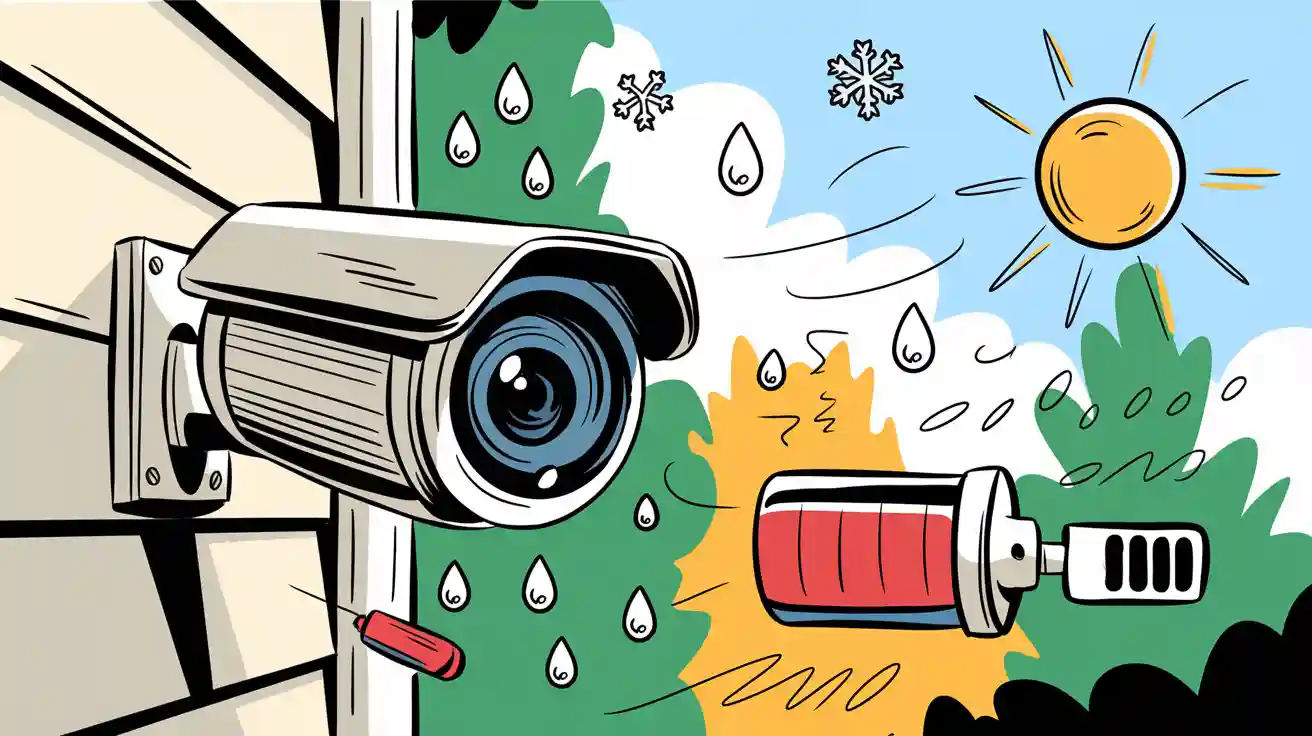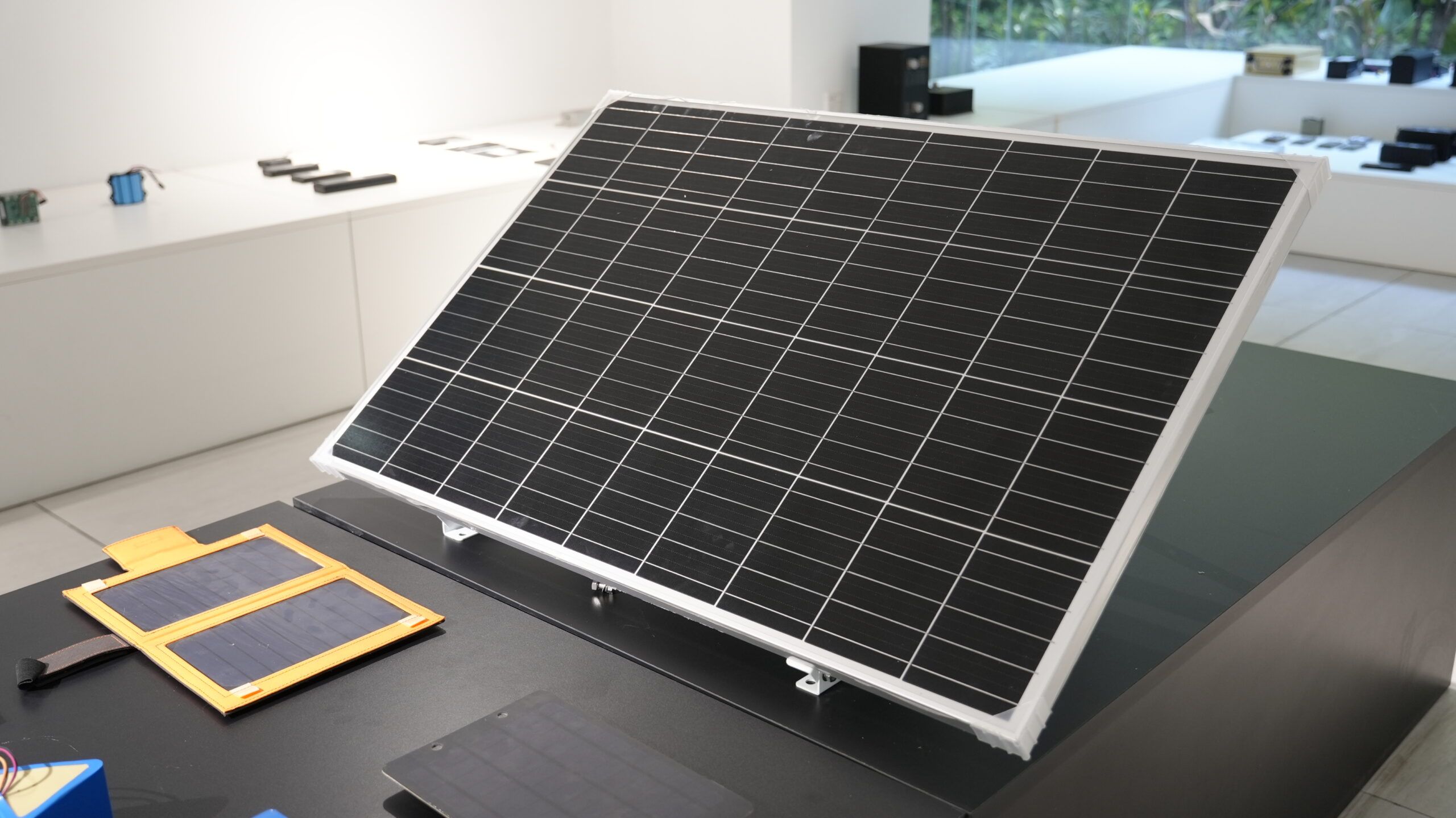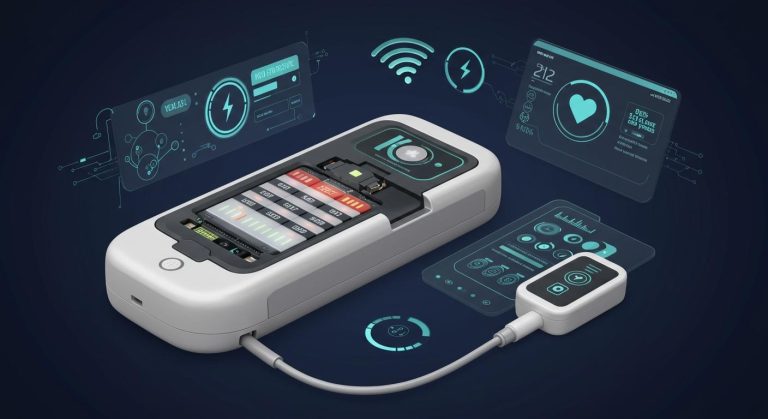
You face unique challenges when managing outdoor camera batteries in changing weather conditions. Cold temperatures, high humidity, and heat can all change how lithium battery packs perform in security systems. Many businesses see batteries drain faster or even fail when humidity rises or temperatures drop. Knowing how these factors affect your equipment helps you keep your security cameras running smoothly.
Key Takeaways
Cold weather can drain outdoor camera batteries quickly. Use high-quality, cold-rated batteries to maintain performance.
Heat can cause lithium batteries to degrade faster. Install cameras in shaded areas to protect them from direct sunlight.
Regular maintenance is key. Clean camera lenses and check for moisture to ensure reliable operation.
Monitor battery status year-round. This helps prevent unexpected failures and keeps your security systems running smoothly.
Choose the right battery chemistry. LiFePO4 and LTO batteries perform well in extreme temperatures, ensuring reliability.
Part 1: Weather Conditions and Battery Performance
1.1 Lithium Battery Chemistry
You rely on lithium battery packs for outdoor cameras because they offer high energy density and stable voltage. However, weather conditions can change how these batteries work. Different lithium chemistries—such as LiFePO4, NMC, LCO, LMO, LTO, solid-state, and lithium metal—respond differently to temperature swings, humidity, and precipitation. Security systems, medical devices, robotics, and industrial equipment all use these chemistries for reliable power.
Chemistry | Cold Weather Performance | Heat Tolerance | Typical Use Case |
|---|---|---|---|
LiFePO4 | Good above -20°C | High | Security, industrial, robotics |
NMC | Moderate above -10°C | Moderate | Consumer electronics, medical |
LCO | Poor below 0°C | Low | Consumer electronics |
LMO | Moderate above -10°C | Moderate | Infrastructure, power tools |
LTO | Excellent to -30°C | High | Medical, industrial, robotics |
Solid-State | Promising, still new | High | Next-gen security, medical |
Lithium Metal | Poor below 0°C | Low | Research, specialty applications |
Cold weather slows down the chemical reactions inside lithium batteries. The electrolyte becomes thick, and lithium ions move slowly. This can cause lithium plating, which damages the battery and shortens battery life. In cold climates, you may see a daily drop in capacity between 1% and 4% when temperatures fall below 3°C. Even at 0°F, lithium batteries lose 10-20% capacity but still function. Charging below freezing can cause swelling or internal short circuits.
Humidity and precipitation also affect battery performance. Water can break down electrolyte solvents and dissolve lithium salts, leading to capacity loss and even internal short circuits. You must protect outdoor camera batteries from moisture to avoid these risks.
1.2 Key Metrics Affected
Weather conditions impact several key metrics for outdoor camera batteries:
Metric | Cold Weather Impact | Heat Impact | Humidity/Precipitation Impact |
|---|---|---|---|
Capacity | Up to 20% loss at 0°C, 50% at -20°C | Faster aging, reduced efficiency | Gradual loss due to material breakdown |
Voltage | Increased internal resistance | Voltage instability | Short circuits possible |
Safety | Dendrite formation, short circuits | Thermal runaway risk | Water-induced failure |
Cold weather can slow discharge rates and reduce battery performance.
Extreme heat accelerates wear, shortens battery life, and increases the risk of overheating.
Moisture exposure leads to chemical breakdowns and can cause batteries to fail.
Tip: Always monitor outdoor camera batteries for temperature-related battery issues, especially during winter weather or heat waves. Proper housing and regular checks help maintain battery performance and safety.
Part 2: Cold Weather Impact on Outdoor Camera Batteries

2.1 Common Cold Weather Issues
Cold weather creates unique challenges for outdoor camera batteries. When you deploy outdoor cameras in regions with subzero temperatures, you often notice that batteries will drain much faster. Lithium battery packs, which power most outdoor security cameras, lose efficiency as the temperature drops. The chemical reactions inside these batteries slow down, reducing current output and causing rapid battery drainage. In extreme cold, batteries may stop delivering electrons effectively, leading to sudden camera shutdowns.
You should avoid charging batteries below 32°F. Charging at lower temperatures, such as -4°F, can cause permanent damage and significantly reduce battery life. Outdoor camera batteries in cold weather may also experience operational limits, with some models failing to function below -4°F. These issues become more pronounced in battery-powered cameras, especially in winter weather or harsh weather conditions.
Note: Using Large Power’s proprietary low-temperature lithium batteries helps maintain reliability in cold temperatures.
2.2 Warning Signs in Outdoor Cameras
You can spot temperature-related battery issues in outdoor cameras by watching for several warning signs:
Reduced battery life and faster charge loss
Camera shutdowns due to insufficient power
Slower operation or delayed responses from the camera
Image quality problems, such as condensation or frost on the lens
Condensation and frost can form inside the camera housing when cold air meets warmer internal components. This exposure to moisture can cause weather-related damage and impact the efficiency of your security system. If you notice these symptoms, your outdoor camera batteries may not be coping well with the current weather conditions.
2.3 Mitigation Strategies
You can take several steps to protect outdoor camera batteries and maintain battery performance during cold weather. Start by selecting cameras designed for extreme temperature ranges and robust weatherproofing. Models with IP66 or IP67 ratings offer strong protection against moisture and harsh weather conditions. Built-in heaters or blowers help prevent condensation and frost, keeping your cameras operational even in the coldest environments.
Here are some effective strategies:
Check the camera housing’s IP rating for weather resistance.
Inspect the enclosure for moisture or condensation.
Use silica gel packets to protect cables and connectors.
Choose cold-weather rated cameras with built-in heaters.
Install cameras under eaves or use weatherproof housing.
Regularly clear snow and ice from camera lenses.
Keep firmware up to date and limit unnecessary camera usage.
Place cameras in areas with strong mobile signal power.
You should also perform regular maintenance to ensure your cameras stay in top condition. In industries like security systems, medical devices, robotics, and infrastructure, these steps help maintain efficiency and reliability throughout the winter.
Wired vs. Wireless Outdoor Security Cameras in Cold Weather
Wired and wireless outdoor security cameras respond differently to cold weather. The table below highlights key differences:
Feature | Wired Outdoor Cameras | Wireless Outdoor Cameras |
|---|---|---|
Power Source | Direct power supply (less affected by cold) | Battery-powered (more affected by cold) |
Cold Weather Impact | More stable performance | Batteries will drain faster |
Maintenance Needs | Lower (no battery swaps) | Higher (frequent battery changes) |
Application Scenarios | Infrastructure, industrial, medical | Security systems, consumer electronics, robotics |
Wired cameras often remain unbothered by the weather, as they do not rely on batteries. Wireless models, however, need more attention in cold weather because their batteries lose efficiency and require frequent replacement or recharging.
Tip: For critical applications in medical, industrial, or security sectors, consider hardwired cameras or models with advanced battery heating solutions to ensure continuous operation during temperature extremes.
By following these strategies, you can reduce weather-related damage and keep your outdoor camera batteries performing well, even in the most challenging winter weather.
Part 3: Heat Effects on Outdoor Security Cameras

3.1 Battery Degradation in Heat
You face serious challenges when outdoor camera batteries operate in hot environments. Heat accelerates chemical reactions inside lithium battery packs, which leads to faster aging and reduced battery life. When temperatures rise above 90°F, you see a sharp drop in battery performance and efficiency. For example, NiMH batteries can lose up to 20% of their capacity in these conditions. Lithium battery packs degrade even faster. As temperature increases from 25°C to 55°C, the rate of maximum charge storage loss jumps from 4.22% to 13.24% after 260 cycles. This means your batteries will not last as long, and you will need to replace them more often.
Thermal runaway is a major risk in high temperatures. The battery’s internal pressure rises as gas forms inside the cell. If the temperature reaches 60°C, venting and swelling can occur. Above 130°C, the risk of combustion becomes immediate. You must pay close attention to these risks, especially in weatherproof outdoor cameras used in security systems, medical devices, robotics, and industrial infrastructure.
Temperature (°C) | Internal Pressure (bar) | Risk Level |
|---|---|---|
Up to 60 | Increased pressure due to gas formation | Risk of venting and swelling |
60 to 130 | Pressure buildup leading to thermal runaway | High risk of combustion |
Above 130 | Significant pressure increase | Immediate risk of fire |
Heat also causes condensation inside camera housings. This moisture can break down battery materials and reduce efficiency. You must monitor weather conditions and keep batteries protected from both heat and humidity.
Tip: Choose lithium battery chemistries like LiFePO4 or LTO for better heat tolerance in outdoor cameras. These types perform well in hot climates and industrial settings.
3.2 Overheating Symptoms
You can spot overheating in outdoor security cameras by watching for several warning signs. These symptoms indicate that your outdoor camera batteries are struggling with high temperatures and losing efficiency:
Fuzzy or glitchy video feeds
Sudden restarts
Connection drops
Warped outer casings
If you notice condensation inside the camera or swelling of the battery pack, act quickly. These signs mean the battery is at risk of failure or even fire. In medical and robotics applications, overheating can disrupt critical operations. In security systems, it can leave your property unprotected.
Alert: Never ignore warped casings or sudden shutdowns. These symptoms point to dangerous battery conditions.
3.3 Preventive Measures
You can protect outdoor camera batteries from heat damage by following several best practices. Start by installing cameras in shaded areas or under eaves to reduce direct sun exposure. Use weatherproof outdoor cameras with high IP ratings to keep out moisture and prevent condensation. Select lithium battery chemistries designed for high temperatures, such as LiFePO4 or LTO, for better efficiency and safety.
Here are some steps you can take:
Install cameras away from direct sunlight.
Use weatherproof housings with ventilation.
Monitor battery temperature with smart sensors.
Schedule regular maintenance checks during hot weather.
Replace batteries before peak summer months.
Update firmware to optimize battery performance.
In industrial, medical, and security sectors, these measures help maintain battery life and efficiency. You reduce the risk of thermal runaway and keep your outdoor cameras running smoothly, even in extreme weather conditions.
Note: Always follow manufacturer guidelines for battery storage and operation. For more information on lithium battery safety, visit Nature Energy.
By taking these steps, you ensure reliable battery performance and protect your investment in outdoor security cameras.
Part 4: Best Practices for Outdoor Camera Batteries
4.1 Installation Tips
You can optimize battery performance by following proven installation strategies for outdoor camera batteries. Position your cameras away from high-traffic areas to reduce unnecessary motion triggers. Remove obstructions such as tree branches to maintain a clear view. Mount your cameras 6 to 8 feet above the ground at a 30-degree angle facing downward. This placement improves coverage and reduces battery drain. Lower motion sensitivity settings to Default or Low, and enable People-Only Detection to limit false alerts. Set up Activity Zones so your cameras only monitor critical areas. For better visibility, install cameras at a height of 9 to 10 feet and choose locations with strong Wi-Fi signals. Regularly check battery life and update firmware to maintain reliable operation.
Tip: Adjust motion zones and sensitivity settings to extend battery life in security systems, medical devices, and industrial applications.
4.2 Insulation and Housing
Proper insulation and housing protect outdoor camera batteries from extreme temperatures. You can use several methods to maintain stable battery performance:
Insulation Method | Description |
|---|---|
Thermal Wraps | Covers battery packs with foam, rubber, or aerogel for high-performance insulation. |
Heated Battery Systems | Uses heating elements with insulation to keep batteries at optimal temperature. |
Insulated Enclosures | Shields larger battery systems with enclosures that stabilize internal temperatures. |
Thermal wraps and heated systems work well in cold climates. Insulated enclosures provide extra protection for lithium battery packs in industrial and infrastructure settings. These solutions help you avoid battery degradation caused by weather conditions.
4.3 Maintenance Protocols
You should follow a seasonal maintenance schedule to ensure year-round reliability for outdoor camera batteries. The table below outlines recommended actions:
Season | Maintenance Actions |
|---|---|
Spring | Clean camera and battery contacts. Replace degraded batteries. |
Summer | Check for overheating. Move cameras if exposed to excessive sun. |
Autumn | Test battery capacity before cold weather. Charge batteries fully. |
Winter | Use battery warmers or insulation. Reduce camera settings to save power. |
Monitor battery levels remotely using cloud management tools. Schedule preventive maintenance during moderate weather. Keep firmware updated to improve power management. Clean solar panels if your system uses them. Regularly inspect for physical damage or wear. Test battery health and recharge often, especially in regions with extreme weather. Maintain clean camera lenses for clear video. These steps support reliable operation in security, medical, robotics, and industrial sectors.
Note: Consistent maintenance and smart installation choices help you maximize the lifespan and efficiency of outdoor camera batteries.
You see the biggest battery challenges when temperatures swing or humidity rises.
Cold weather causes rapid battery drain in wire-free cameras, while wired models stay more stable.
Hot weather can overheat lithium battery packs, damaging camera components.
Regular upkeep, like cleaning lenses and checking for moisture, keeps cameras working longer and reduces failure.
Use smart features such as motion-triggered modes and strong WiFi to optimize battery health.
Monitor battery status year-round to prevent downtime and protect your security, medical, or industrial systems.
Staying proactive with maintenance and smart usage helps your outdoor cameras deliver reliable performance in every season.
FAQ
What is the best lithium battery chemistry for outdoor cameras in extreme weather?
You should choose LiFePO4 or NMC batteries for outdoor cameras. These chemistries handle both cold and heat well. They work reliably in security systems, medical devices, robotics, and industrial settings.
How often should you replace outdoor camera batteries in harsh climates?
You should check battery health every season. In harsh climates, replace lithium battery packs every 1–2 years. Regular checks help you avoid sudden failures in security or industrial applications.
Can you use solar panels to extend battery life for outdoor cameras?
Yes, you can use solar panels with lithium battery packs. Solar charging works well for security cameras, infrastructure, and remote industrial sites. Always use weatherproof panels and monitor charging performance.
What maintenance steps help prevent battery failure in outdoor cameras?
You should clean battery contacts, check for moisture, and update firmware. Schedule seasonal inspections. These steps keep lithium battery packs reliable in medical, robotics, and security systems.
Do wireless outdoor cameras need more battery care than wired models?
Yes, you need to monitor wireless camera batteries more often. Wireless models rely on lithium battery packs, which drain faster in extreme weather. Wired cameras use direct power and need less battery maintenance.






